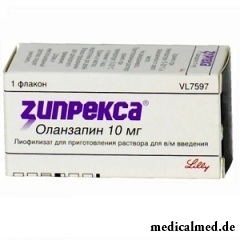





Zipreksa
Application instruction:
 Zipreksa – the antipsychotic means applied at treatment of schizophrenia and bipolar affective disorders.
Zipreksa – the antipsychotic means applied at treatment of schizophrenia and bipolar affective disorders.
Form of release and structure
- Tablets, film coated: round, white color, on one of the parties the identification text, depending on the content of active agent is printed: 2,5 mg - "LILLY 4112", 5 mg - "LILLY 4115", 7,5 mg - "LILLY 4116", 10 mg - "LILLY 4117" (on 7 pieces in blisters, on 1, 2, 4, 8 blisters in a cardboard pack);
- Lyophilisate for preparation of solution for intramuscular introduction (in oil): the condensed mass or powder of yellow color (on 10 mg in bottles, on 1 bottle in a cardboard pack).
Structure of 1 tablet:
- Active ingredient: olanzapine – 2,5 mg, 5 mg, 7,5 mg or 10 mg;
- Auxiliary components: hydroxypropyl cellulose (hypro rod), кросповидон, monohydrate of lactose, magnesium stearate, microcrystallic cellulose;
- Cover: methylhydroxypropyl cellulose (gipromelloza), mix of white dye, karnaubsky wax (for polish), blue food ink (for drawing an identification text).
Structure of 1 bottle of lyophilisate:
- Active ingredient: olanzapine – 10 mg;
- Auxiliary components: tartaric acid, monohydrate of lactose.
Indications to use
Tablets, film coated
- Bipolar affective disorder: Zipreksa in monotherapy or in a combination with Valproatum or lithium is applied to treatment of the mixed or acute maniacal episodes at bipolar affective disorder with psychotic manifestations and bystry change of phases, or without them; it is also shown to patients with bipolar disorder at whom olanzapine was effective for treatment of a maniacal phase for prevention of a recurrence;
- Schizophrenia: therapy of aggravations; the supporting and prolonged antirecurrent treatment, both schizophrenia, and other psychotic frustration with the expressed symptomatology (negative (including emotional flatness, depletion of the speech, decrease in social activity) and/or productive (including hallucinations, nonsense, automatism)) and the accompanying affective frustration.
Olanzapine in a combination with fluoxetine is shown for treatment of the depressions connected with bipolar disorder.
Lyophilisate for preparation of solution for introduction in oil
Injection administration of olanzapine is recommended for bystry stopping of psychomotor excitement (agitation) at patients with bipolar affective disorder and schizophrenia.
Contraindications
The diagnosed hypersensitivity to any of Zipreksa's components.
Route of administration and dosage
Tablets, film coated
Pill is taken inside, irrespective of meal.
The daily dose is selected individually and depends on a clinical condition of the patient. It is necessary to increase a dose over standard gradually (maintaining an interval at 24 o'clock at least), and only after carrying out the corresponding clinical inspection.
The recommended dosing mode:
- Schizophrenia and similar psychotic frustration: an initial dose of drug (it – standard) – 10 mg of 1 times a day; therapeutic doses – from 5 to 20 mg a day;
- Acute mania at bipolar disorder: an initial dose of drug (it – standard) – 15 mg of 1 times a day; therapeutic doses – from 5 to 20 mg a day.
With heavy degree of a renal failure the initial dose of olanzapine – 5 mg a day is recommended to elderly people, patients with a liver failure of moderate severity.
Also decrease in an initial dose of Zipreksa is shown at a combination of the following factors: female patients, non-smoking, patients of senile age – in connection with possible delay of metabolism of active ingredient.
Lyophilisate for preparation of solution for introduction in oil
The solution prepared from lyophilisate is entered intramusculary. It is not necessary to administer the drug subcutaneously or intravenously.
Use of olanzapine in the form of an injection is necessary for bystry stopping of a condition of agitation at patients with bipolar affective disorder and schizophrenia.
The recommended initial dose – 10 mg (a single injection in oil). Further, taking into account a clinical condition of the patient not earlier than in 2 hours, it is allowed to make the second injection – to 10 mg. At least 4 hours later after the second injection it is allowed to make a third – to 10 mg. Safety of a dose more than 30 mg a day was not estimated in clinical trials.
In the presence of indications for therapy continuation intramuscular injections of Zipreksa need to be cancelled and passed in case of clinical expediency to oral administration of olanzapine in a dose from 5 to 20 mg.
The single intramuscular injection of drug in a dose of 2,5-5 mg is recommended to elderly people or patients with other clinical risk factors.
Lyophilisate is allowed to be dissolved exclusively sterile water for injections.
It is not necessary to mix olanzapine in one syringe with lorazepam, diazepam and a haloperidol as are possible lengthening of time of dissolution, precipitation and/or weakening of effect of olanzapine.
For preparation of solution for contents of a bottle it is necessary to add 2,1 ml of sterile water for injections:
- Solution has to be yellow color, transparent;
- It is necessary to use solution within 1 hour after preparation;
- The unused rest should be merged;
- Before introduction it is necessary to check solution on presence of mechanical impurities (if the container and solution allow to make it).
The olanzapine dose in mg corresponding to the volume of the used solution for an injection in oil:
- All contents of a bottle – 10 mg;
- 1,5 ml – 7,5 mg;
- 1 ml – 5 mg;
- 0,5 ml – 2,5 mg.
The overdose of olanzapine is very often shown by tachycardia, excitement/aggression, a dysarthria, various extrapyramidal disorders and disturbances of awareness of various degrees of severity (from sedation to a coma). Can be other clinically significant effects: malignant antipsychotic syndrome, delirium, spasms, respiratory depression, aspiration, decrease or increase in the arterial pressure (AP), arrhythmia, and also cardiac standstill and breath. The minimum registered olanzapine dose in case of acute overdose with a lethal outcome – 450 mg, maximum at overdose with survival (a favorable outcome) – 1500 mg.
The specific antidote at drug does not exist. It is not necessary to provoke vomiting. It is allowed to carry out procedures, standard at overdose: reception of absorbent carbon, gastric lavage.
The symptomatic treatment corresponding to a clinical condition of the patient and control of functions of vitals is recommended (including maintenance of respiratory function, therapy of a vascular collapse and lowering of arterial pressure). It is impossible to apply a dopamine, Epinephrinum and other sympathomimetics, agonists of β-adrenoceptors, as stimulation of these receptors can strengthen a lowering of arterial pressure.
Side effects
The side effects connected using olanzapine according to clinical trials:
- Very often (> 1/10): drowsiness and increase in body weight, poorly expressed tranzitorny increase in concentration of prolactin in plasma (to 34% of cases) *;
- Often (<1/10-≥ 1/100): dizziness, an adynamy, an akathisia, increase in appetite, peripheral hypostases, orthostatic hypotension, locks, dryness in a mouth;
- Seldom (<1/1000-> 1/10 000): tranzitorny symptomless increase in hepatic indicators of ALT (alaninaminotranspherase) and nuclear heating plant (aspartate aminotransferase) in blood serum;
- In isolated cases (<1/10 000): increase in concentration of glucose in a blood plasma of ≥200 mg/dl (suspicion on a diabetes mellitus), increase in concentration of glucose in a blood plasma from ≥160 mg/dl to <200 mg/dl (suspicion on a hyperglycemia) at basic level of glucose of ≤140 mg/dl.
Note:
* – The maximum values of concentration of prolactin on average do not reach the upper bound of norm and statistically authentically do not differ from placebo; clinical symptoms and signs of a giperprolaktinemiya, such as gynecomastia, increase in mammary glands and a galactorrhoea, are noted seldom; in most cases normalization of level of prolactin happens without Zipreksa's cancellation.
In clinical trials with the assistance of 1185 patients (N=1185) increase in level of triglycerides on average on 20 mg/dl from basic was noted.
By results of placebo - controlled researches (N=2528) cholesterol level on average increased by 0,4 mg/dl from basic.
Isolated cases of a symptomless eosinophilia were celebrated.
Aggregated data about the main side effects and frequency of their manifestation (by results of clinical tests and/or to data of the post-registration period at treatment by various dosage forms of Zipreksa):
- Organism in general: very often – increase in weight tela1; often – asteniya2; infrequently – raised svetochuvstvitelnost2;
- Cardiovascular system: often – orthostatic gipotenziya1; infrequently – bradikardiya2;
- Alimentary system: often – zapory2, dryness in rtu2, increase appetita2; very seldom – gepatit3;
- Metabolic disturbances: often – peripheral oteki2; very seldom – diabetic koma3, diabetic ketoatsidoz3,5, giperglikemiya3, gipertriglitseridemiya3,6;
- Nervous system: very often – disturbance pokhodki4, sonlivost2; often – akatiziya2, golovokruzheniye2; seldom – convulsive pripadki3;
- Skin and appendages: seldom – syp3;
- Urinogenital system: very seldom – priapizm3;
- Clinical biochemistry: very often – increase prolaktina1; often – increase in ALT1, increase in ACT1, isolated cases of increase in concentration of glucose of ≥160 mg / дл-<200 mg/dl (suspicion on a hyperglycemia) 1, isolated cases of increase in concentration of glucose of ≥200 mg/dl (suspicion of diabetes) 1;
- Hematology: often – eozinofiliya1; seldom – leykopeniya3; very seldom – trombotsitopeniya3.
Notes
1 – Assessment of indicators from the database of clinical trials.
2 – The side effects registered in the database of clinical trials.
3 – The side effects registered spontaneously during the post-market researches.
4 – The side effects found during clinical trials in patients with dementia of altsgeymerovsky type.
5 – Diabetic acidosis on classification in the dictionary of symbols of coding for adverse reactions (COSTART).
6 – A lipidemia on COSTART classification.
Gradation of frequency depending on quantity of noted episodes: very often (> 1/10); often (<1/10,> 1/100); infrequently (<1/100,> 1/1000); seldom (<1/1000,> 1/10 000); very seldom (<1/10 000).
Special instructions
Therapy by any neuroleptics, including olanzapine, can become the reason of development of the malignant antipsychotic syndrome (MAS) – potentially fatal symptom complex. Clinical manifestations of ZNS: substantial increase of body temperature, change of the mental status, muscle tension, vegetative disturbances (unstable the ABP, pulse, cardiac arrhythmias, tachycardia, the increased sweating). Can be additional confirmation of ZNS: increase in level of a kreatinfosfokinaza, myoglobinuria (рабдомиолиз), acute renal failure. Such clinical manifestations of ZNS, or essential temperature increase without other symptoms, demand cancellation of all neuroleptics, including olanzapine.
During the comparative researches for more than 6 weeks therapy by olanzapine was followed by development of the dyskinesia demanding medicamentous correction than treatment a haloperidol authentically less often. At the same time it is necessary to consider risk of late dyskinesia in case of long therapy by neuroleptics. In case of development of symptoms of late dyskinesia the dose decline or cancellation of olanzapine is recommended. After drug withdrawal can accrue or demonstrate symptoms of late dyskinesia.
In some cases Zipreksa's use, as a rule, at the beginning of therapy, was followed by symptomless, tranzitorny increase in levels of hepatic transaminases (ALT and nuclear heating plant). Extra care at such increase should be observed the patient with a liver failure, with a limited functional reserve of a liver, or in case of therapy by potentially hepatotoxic drugs. Increase in the ALT and/or nuclear Heating Plant levels during treatment demands careful observation of the patient and, if necessary, dose declines.
With care drug in the presence of data in the anamnesis on epileptic seizures, or sick, subject to influence of the factors reducing a threshold of convulsive readiness is used. Convulsive attacks at such patients during therapy by olanzapine were observed seldom.
It is also necessary to show care at: the lowered quantity of neutrophils and/or leukocytes; signs of toxic disturbance / oppression of function of marrow under the influence of medicines in the anamnesis; the oppression of function of marrow caused by associated diseases; radiotheraphy or chemotherapy in the anamnesis; hypereosinophilia; myeloproliferative diseases.
By results of clinical trials a recurrence of a klozapinzavisimy neutropenia or agranulocytosis at use of olanzapine for patients with existence of data on these frustration in the anamnesis is not celebrated.
During conduct of clinical trials Zipreksa's use by side effects of anticholinergic character was followed seldom. However, in the presence of associated diseases, clinical experience of use of olanzapine is limited therefore it is necessary to show care at clinically significant prostatauxe, paralytic impassability of intestines, closed-angle glaucoma and similar states.
In vitro olanzapine acts as the antagonist to a dopamine and, as well as other neuroleptics, is theoretically capable to suppress action of agonists of a dopamine and levodopa.
Considering the main action on the central nervous system (CNS), it is necessary to be careful, using drug in combination with other medicines of the central action and etanolsoderzhashchy substances.
Effect of olanzapine for injections in oil in an age group of patients up to 18 years was not studied.
Olanzapine is capable to cause drowsiness therefore in the course of therapy by Zipreksa it is recommended to observe the increased care, managing mechanical means, including the car.
Medicinal interaction
At simultaneous use of Zipreksa with some medicines can arise following effects:
- Absorbent carbon: at oral administration of olanzapine reduces its bioavailability to 50-60%;
- Antacids: aluminum - or magniysoderzhashchy, Cimetidinum – use in a single dose does not break Zipreksa's bioavailability in the form of tablets;
- Valproic acid: clinically significant pharmacokinetic interaction with olanzapine is improbable;
- Substances/drugs, metaboliziruyemy with participation of CYP1A2, such as theophylline: their pharmacokinetics generally does not change as olanzapine is not potential inhibitor of activity CYP1A2;
- Known potential CYP1A2 inhibitors: can reduce clearance of olanzapine;
- Isoenzymes of P450 cytochrome (CYP1A2, CYP2C9, CYP2C19, CYP2D6 and CYP3A): olanzapine is potentially not capable to suppress their activity (according to the researches in vitro with use of microsomes of a liver of the person);
- Imipraminum or its metabolite desipramine (CYP2D6, CYP3A, CYP1A2), warfarin (CYP2C19), theophylline (CYP1A2) or diazepam (CYP3A4, CYP2C19): metabolism of the specified substances is not oppressed (according to clinical trials, at their introduction with a single dose of olanzapine);
- The inhibitors or inductors of isoenzymes of P450 cytochrome showing specific activity concerning CYP1A2: can change olanzapine metabolism;
- Carbamazepine and smoking of the patient: increase clearance of olanzapine (increasing activity of CYP1A2);
- Lithium, Biperidinum: signs of medicinal interaction are not revealed;
- Lorazepam: at administration of lorazepam in oil in a dose of 2 mg 1 hour later after an injection of olanzapine in oil in a dose of 5 mg of considerable influence on pharmacokinetics of olanzapine and the general or not conjugated lorazepam it was not noted, but such combination of injections increases the drowsiness noted at use of each of drugs separately;
- The drugs capable to lower the ABP the mechanisms other than adrenergic antagonism α-1: decrease in the ABP and/or bradycardia at intramuscular administration of olanzapine, thanks to its activity as adrenergic antagonist α-1 is possible;
- Fluvoksamin (CYP1A2 inhibitor): reduces clearance of olanzapine, increasing average value its Cmax: at non-smoking women for 54%, at the smoking men for 77%; average AUC value: for 52% and 108% respectively. Olanzapine in small doses should be accepted the patient receiving treatment fluvoksaminy;
- Fluoxetine (at a single dose of 60 mg or 60 mg daily within 8 days): causes increase in the maximum concentration of olanzapine on average by 16% and also on average for 16% – decrease in its clearance. It is not recommended to change an olanzapine dose at its appointment in a combination with fluoxetine;
- Ethanol: changes of pharmacokinetics of ethanol against the background of steady concentration of olanzapine were not noted, but at such combination strengthening of pharmacological effect of olanzapine, for example, sedative is possible.
Terms and storage conditions
To store in the protected from light, dry place unavailable to children at temperature of 15-30 °C. Not to freeze lyophilisate.
Period of validity – 3 years.
The prepared solution should be used within an hour.
Name of drug
Price
Drugstore
Zipreksa Zidis тбл дисперг 5 mg No. 28, Eli Lilly
2576 rub.
 Network of the Moscow drugstores of IFC
Network of the Moscow drugstores of IFCZipreksa тбл п / about 5 mg No. 28, Eli Lilly
2607 rub.
 Network of the Moscow drugstores of IFC
Network of the Moscow drugstores of IFCZipreksa тбл п / about 10 mg No. 28, Eli Lilly
5048 rub.
 Network of the Moscow drugstores of IFC
Network of the Moscow drugstores of IFCWork which to the person not to liking, is much more harmful to his mentality, than lack of work in general.

Not everyone can brag of the shining Hollywood smile. Even at the person who is regularly visiting the stomatologist and watching з...
Section: Articles about health
The endocrine system carries out extremely important role in a human body, practically all processes of life activity are regulated by it. Closed glands (hemadens) produce special biologically active agents – hormones which then o...
Section: Articles about health
Each woman has preferences in the field of use of those goods which help us to look good, feel young and effective. Besides: selection process of favourite perfume, shampoo or decorative cosmetics already lightens the mood and serves as a peculiar stress medicine. Happens very offensively when the acquired perfumery and cosmetic products not only do not meet our expectations, but also becomes the reason of problems with health. Sources неприятн...
Section: Articles about health
All are familiar with cold, and practically everyone believes that he has sufficient knowledge and experience that correctly to treat it. N...
Section: Articles about health
The summer of this year in Russia was very ambiguous. Regions suffered from a merciless heat, from pouring rains, the hail from time to time dropped out, then there was again a heat which alternated with rainfall again. Many people suffer from such sharp changes of weather...
Section: Articles about health
New year, wedding, birthday, office party – an occasion to drink at the Russian person will always be. How to reduce a negative impact of alcohol by an organism and to avoid a condition of strong intoxication? The most correct council – to refuse the use of alcoholic drinks. Council is true, but not always feasible. We offer several advice which will help you in cases when it is impossible to avoid alcohol intake....
Section: Articles about health
Sooner or later hair turn gray at all. Many people try to hide these changes, returning natural color of the hair with the help about...
Section: Articles about health
For most of the working people the problem of having a snack is particularly acute enough. Sooner or later there is a question: what can be eaten quickly between a breakfast and a lunch or a lunch and leaving from service so that to receive necessary power feed, but not an overload...
Section: Articles about health
Olive oil – the product capable to make a powerful contribution to health of the person if it includes it in the diet. The rich vitamin composition of oil does it by a product number one from many diseases including from deadly. Only two tablespoons of oil from olives in day prevent emergence of diseases of vessels and heart, cancer, problems with digestion, presenilation, a depression and many other illnesses which treatment would demand a lot of time and forces. Let's consider on...
Section: Articles about health
Traveling all over the world, many try to try the most exotic dishes of national cuisines. Exists even so-called died away...
Section: Articles about health
Scientists always aimed to offer fundamental explanations for medical problems. Their theories formed the basis of modern methods of treatment of the hardest pathologies and helped to save a set of lives. However stories are known also such theoretical constructions, following to...
Section: Articles about health
Smoking not only exerts a negative impact on the state of health of the consumer of tobacco products, but is an air polluter the substances potentially dangerous to people around. In recent years significantly the number of the people aiming to get rid of an addiction increased. Business this difficult: having left off smoking, the person immediately begins to suffer from abstinence. Besides, many yesterday's smokers feel at first great disappointment as улучш...
Section: Articles about health
Coffee – favourite drink of many. For the last decades it more than once already declared very harmful, extremely useful and even...
Section: Articles about health
Modern footwear is extremely various. It stopped being only protection for legs long ago. Today shoes, boots, barefoot persons choose not so much proceeding from their convenience and functionality how many being guided by outward, brand and an opportunity to add with it...
Section: Articles about health
The problem of diagnosis was and remains to one of the most important in medicine. From that, the reason of an indisposition of the patient will be how precisely defined, eventually success of treatment depends. In spite of the fact that the majority of the diagnostic methods applied in official clinical practice has very high informational content and reliability, mistakes directed by diagnoses nevertheless are not excluded....
Section: Articles about health
Dark circles (bruises) under eyes – a shortcoming with most of which often fight against the help of cosmetics (proofreaders, salons...
Section: Articles about health
All of us, unfortunately, should face flu nearly an every year. It would seem, so frequent disease has to be studied already up and down, and each person, at least once by it had (and the number of such people in our country aims at 100%), a dolzha...
Section: Articles about health
Subfebrile temperature call fervescence to 38 degrees, and subfebrile condition - existence of such temperature over 3 days, and quite often it happens without the visible reasons. Existence of subfebrile condition - a strong indication of disturbances in an organism which can be caused by various reasons: disease, stresses, hormonal failures. Despite the seeming inoffensiveness it is a state at which people often continue to lead a usual life, often is a sign of many of a zabolev...
Section: Articles about health
The trophic ulcer is not an independent disease. This heavy complication arising owing to a thermal injury (a burn...
Section: Articles about health
Frosty air, fresh wind and easy snowball at most of Russians are associated with cheerfulness, health and cheerful entertainments on which our winter is so generous. But, unfortunately, cold season sometimes brings also troubles with health. It is not about a season...
Section: Articles about health
Heart disease and blood vessels lead to disturbance of blood supply of bodies and fabrics that involves failures in their work, deterioration in health of the person, decrease in its working capacity and standard of living. Annually more than 17 million inhabitants of our planet perish from pathologies such....
Section: Articles about health
Healthy lifestyle today in fashion, and many parents think of that the child from the early childhood played sports. To a Torah...
Section: Articles about health
The winter swimming in open reservoirs called in our country by "winter swimming" – officially recognized sport and one of the most extreme ways of a hardening of an organism. This occupation has an old story and adherents in many countries. Are annually carried out...
Section: Articles about health
High temperature - a frequent symptom of such widespread diseases as a SARS, quinsy, pneumonia, etc. To reduce heat, having facilitated a condition of the patient, doctors recommend to accept antipyretics, however their use is not always possible. Too frequent use of these drugs can lead to allergic reactions, and also overdose, causing poisoning. It happens also that there are no antipyretics simply in the house. In these situations it is pertinent to use it...
Section: Articles about health
The person, as well as all other beings living on our planet feels weather changing. It is normal meteosensitivity, not...
Section: Articles about health
Wood louse – the ordinary-looking unpretentious plant extended in all territory of our country. It quickly expands, and sometimes fills sites, bringing a lot of chagrin to gardeners. Perhaps, they would be upset less if knew that the wood louse is the prices...
Section: Articles about health
Contrary to popular belief, the multiple sclerosis (MS) is not connected neither with sclerous changes of walls of vessels, nor with age forgetfulness and problems with concentration of attention. This disease has the autoimmune nature. Pathological process is expressed in degradation of nervous tissue and destruction of its enveloping layer - a myelin. Multiple damages of the central nervous system which are shown by decrease in sight, bystry fatigue, on become result of development of an illness...
Section: Articles about health

